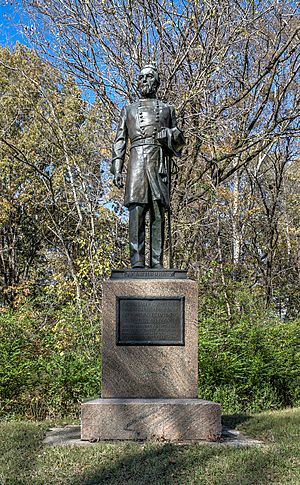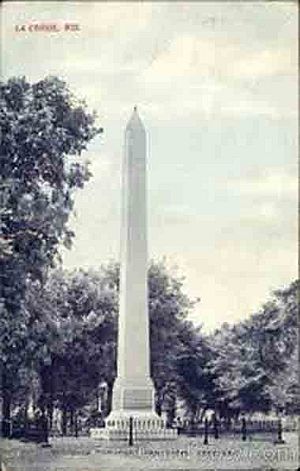Cadwallader C. Washburn facts for kids
Quick facts for kids
Cadwallader C. Washburn
|
|
|---|---|
 |
|
| 11th Governor of Wisconsin | |
| In office January 1, 1872 – January 5, 1874 |
|
| Lieutenant | Milton Pettit |
| Preceded by | Lucius Fairchild |
| Succeeded by | William Robert Taylor |
| Member of the U.S. House of Representatives from Wisconsin's 6th district |
|
| In office March 4, 1867 – March 3, 1871 |
|
| Preceded by | Walter D. McIndoe |
| Succeeded by | Jeremiah McLain Rusk |
| Member of the U.S. House of Representatives from Wisconsin's 2nd district |
|
| In office March 4, 1855 – March 3, 1861 |
|
| Preceded by | Ben C. Eastman |
| Succeeded by | Luther Hanchett |
| Personal details | |
| Born |
Cadwallader Colden Washburn
April 22, 1818 Livermore, Massachusetts (now Livermore, Maine) |
| Died | May 14, 1882 (aged 64) Eureka Springs, Arkansas |
| Resting place | Oak Grove Cemetery, La Crosse, Wisconsin |
| Political party | Republican |
| Spouses |
|
| Children |
|
| Parents |
|
| Relatives |
|
| Profession | lawyer, politician |
| Military service | |
| Allegiance | |
| Branch/service | Union Army |
| Years of service | 1862–1865 |
| Rank | |
| Commands |
|
| Battles/wars | American Civil War |
Cadwallader Colden Washburn (born April 22, 1818 – died May 14, 1882) was an important American businessman, politician, and soldier. He is famous for starting a mill that later became the well-known company General Mills. He was part of the influential Washburn family from Maine. He served as a U.S. Congressman and later as the governor of Wisconsin. During the American Civil War, he was a general in the Union Army.
Contents
Early Life and Education
Cadwallader Washburn was born in Livermore, which was then part of Massachusetts but is now in Maine. His parents were Martha Benjamin and Israel Washburn, Sr.. He was one of seven brothers, many of whom also became famous, including Israel Washburn, Jr., Elihu B. Washburne, William D. Washburn, and Charles Ames Washburn.
Young Washburn went to school in Wiscasset, Maine. He also worked as a teacher there from 1838 to 1839. In 1839, he moved to Davenport, Iowa Territory. There, he continued teaching, worked in a store, and became a surveyor, which means he measured land.
His brother Elihu became a lawyer, which inspired Cadwallader to study law too. In 1842, he passed the test to become a lawyer in Wisconsin. He then moved to Mineral Point, Wisconsin Territory, and started his own law practice.
Building Businesses and Mills
Cadwallader Washburn was very good at business. He started several successful companies.
Land and Banking Ventures
In 1844, Washburn teamed up with a land agent named Cyrus Woodman. They created several businesses, like the Wisconsin Mining Company. Their most successful idea was buying and selling land. In 1855, they opened Washburn's and Woodman's Mineral Point Bank. They ended their partnership that same year, but they remained friends.
Founding General Mills
In 1856, the Minneapolis Mill Company was started in Minnesota. Washburn's cousin, Dorilus Morrison, was one of the founders. The company struggled at first, and some early investors sold their shares. Washburn bought into the company and eventually became its president. His brother William moved to Minneapolis and helped manage the company.
The company built a dam, a canal, and a system of water tunnels. They then rented these, along with land near St. Anthony Falls in Minneapolis, to different types of mills. These included mills for cotton, wool, wood (sawmills), and flour (grist mills). The hard work and investments of the Washburn brothers paid off, and they used their profits to invest in their own mills.
Lumber Industry
In 1853, Washburn built a sawmill in Waubeck on the Chippewa River. After serving in the Civil War, he worked on clearing the Black River to make it easier to float logs downriver. In 1871, he started the La Crosse Lumber Company. This company became very large, cutting 20 million board feet of lumber each year. He also owned the biggest shingle mill in the upper Mississippi Valley.
Flour Milling Success
In 1866, Washburn built his own Washburn "B" Mill. People thought it was too big to make money, but he proved them wrong. In 1874, he built an even larger mill called the Washburn "A" Mill. This original "A" mill was destroyed in a big flour explosion in 1878, but it was rebuilt.
In 1877, Washburn partnered with John Crosby to create the Washburn-Crosby Company. Around the same time, Washburn sent William Hood Dunwoody to England to sell their flour there. Dunwoody was successful and became a silent partner in the company. He later became one of the richest millers in the world and gave a lot of his money to charity, helping to start hospitals and schools like Dunwoody College of Technology. The Washburn-Crosby Company eventually grew into what we know today as General Mills.
Political and Military Service

In 1854, Washburn decided to run for Congress as a Republican. He served three terms in the U.S. House of Representatives, representing Wisconsin's 2nd congressional district from 1855 to 1861. During his time in Congress, he and his brothers voted for Nathaniel P. Banks to become Speaker of the House. He chose not to run for re-election in 1860.
The Washburn family was strongly against slavery. In 1861, Washburn attended a peace meeting in Washington, D.C., hoping to prevent the American Civil War. When the war began, he joined the Union Army. He quickly rose through the ranks, becoming a colonel in the 2nd Regiment Wisconsin Volunteer Cavalry in 1862, then a brigadier general, and finally a major general. President Abraham Lincoln himself signed Washburn's appointment document.
General Ulysses S. Grant once said Washburn was "one of the best administrative officers we have." Washburn led cavalry forces during the early parts of Grant's Vicksburg Campaign. He also commanded a division during other important operations, including the expedition against Fort Esperanza in Texas in 1863.
For the rest of the war, he worked in administrative roles in Mississippi and Tennessee. While he was in charge of Union forces in Memphis, a Confederate general named Nathan B. Forrest tried to kidnap him, but the attempt failed. Washburn left the Union Army on May 25, 1865.
After the war, Washburn returned to his home in La Crosse, Wisconsin. He was elected to the House of Representatives again for two more terms, representing Wisconsin's 6th congressional district from 1867 to 1871. He chose not to run again in 1870.
In 1871, he was encouraged to run for Governor of Wisconsin. Washburn won the election and became governor in January 1872, serving until 1874. He tried to get re-elected in 1873 but was not successful.
A year later, he bought a large estate called Edgewood Villa, which is now where Edgewood College is located.
Family Life and Later Years
Cadwallader Washburn was diagnosed with epilepsy shortly after he was born in 1818.
On January 1, 1849, he married Jeanette Garr. They were both 30 years old. Their first daughter, Jeanette (Nettie), was born in 1850. After Nettie was born, his wife Jeanette began to need special care. After their second daughter, Frances (Fanny), was born in 1852, Washburn made arrangements for his wife to receive the care she needed. She remained in special care until her death in 1909 at the age of 90.
In 1881, Washburn gave his Edgewood Villa estate to the Sinsinawa Dominican Sisters in Madison, Wisconsin. This estate later became Edgewood College and Edgewood High School.
About a year later, on May 14, 1882, Cadwallader Washburn passed away in Eureka Springs, Arkansas. He had been visiting the springs for his health. His body was buried in Oak Grove Cemetery in La Crosse, Wisconsin.
After he died, his estate was worth about two to three million dollars. In his will, Cadwallader left money to his daughter and other family members. He also gave a large amount of money to the city of La Crosse. This money was used to buy land and build the La Crosse Public Library. The largest part of his money was set aside to pay for the care of his wife, Jeanette.
Legacy and Lasting Impact
Many places were named after Cadwallader Washburn to honor him. The city of Washburn in Bayfield County, Wisconsin, and Washburn County in northern Wisconsin are named after him. So is the city of Washburn, North Dakota.
In Minneapolis, the Washburn Center for Children and Washburn High School carry his name. Washburn Observatory at the University of Wisconsin–Madison was also named for him because, as governor, he approved the money for its construction. In La Crosse, Wisconsin, where he lived for a long time and is buried, there is a downtown neighborhood and a park named after him.
See also
- List of American Civil War generals (Union)
- List of U.S. political families
- In Spanish: Cadwallader C. Washburn para niños



